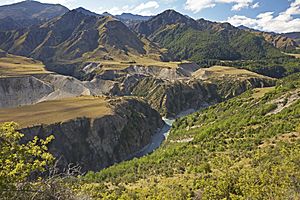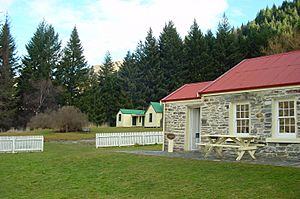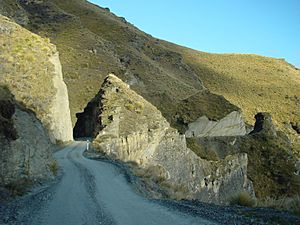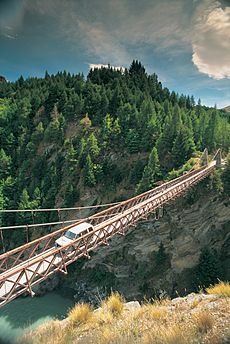Skippers Canyon facts for kids
Skippers Canyon is a beautiful and historic gorge in New Zealand. It is about 22 kilometers long. You can find it several kilometers north of Queenstown.
You can reach Skippers Canyon from Queenstown. The same road also goes to the Coronet Peak ski area. The amazing Shotover River carved out this canyon. The Shotover River was famous for having lots of gold. It was named by William Gilbert Rees. He was one of the first European settlers in the Queenstown area.
Long ago, many gold miners worked in Skippers Canyon. They used Skippers Road to get there. Today, this road is known as one of New Zealand's most scenic drives. Skippers Road is mostly one-way, narrow, and steep. It has sheer drops of several hundred meters. Because of this, most rental car insurance does not cover driving on it. In 1886, Skippers Canyon was also the first place where hydroelectricity was made to power gold mining.
Contents
Discovering Gold in Skippers Canyon
In November 1862, two men named Thomas Arthur and Harry Redfern found gold. They discovered about 4 ounces of gold in just three hours near a place called Arthurs Point. Arthur and Redfern shared their exciting news. Soon, many miners rushed to the area hoping to find their own fortune. This started one of the biggest gold rushes in Otago.
Miners quickly began calling the Shotover River the 'richest river in the world'. However, there is no official proof of this. No records were kept about how much gold was truly found.
Charlestown: A Gold Rush Town
Charlestown was a small town in Skippers Canyon. After gold was found, miners followed the 'golden river' upstream into the gorge. They had to make their own paths over the hills. The river was deep and fast, flowing through steep gorges. But the miners kept going. They climbed mountains and went down to the riverbanks whenever they could.
A big gold discovery happened at a place called Māori Point. Two Māori miners, Dan Ellison and Hakaria Maeroa, found a hidden gorge. They saw gold on the other side of the river. They bravely tried to cross. One of their dogs followed and was swept away. Dan Ellison rescued the dog. On the riverbank, he saw gold in the rocks. He then checked the sand below. With Hakaria's help, they collected 25 pounds (or 300 ounces) of gold before nightfall!
This huge find led to the creation of Charlestown. It was built on the flat land at Māori Point. Soon, hotels, butchers, bakers, a post office, and a bank opened there. There was even a police station and a judge to settle arguments over gold claims. Charlestown quickly grew, with about 1,000 people living there. But by 1864, most of the easy gold was gone. The population dropped to about 400 people. Today, very little remains of Charlestown. You can see some old stones, a small sign, and an information booth.
Skippers Point: Another Gold Hub
The canyon and Skippers Point were named after 'Skipper' Malcolm Duncan. He found gold in the canyon in 1862. Duncan was from Northern Ireland and worked on American ships, which earned him his nickname. He joined the gold rush and found gold at Skippers Creek. This area soon became known as Skippers Point.
In 1866, a new type of power station was built at Dynamo. It was in a branch of Skippers Creek. This station sent electricity 3 kilometers over a hill to Bullendale. Bullendale was a small gold mining village. The electricity powered a machine that helped separate gold from rock. However, this plant did not make a profit.
Besides Duncan, other gold miners also claimed land at Skippers Point. They worked there until the early 1900s. You can still see the remains of their water channels, dams, and mining areas today. A huge basin from the Skippers Sluicing Company is still very clear. It is located below the Mount Aurum Station's Homestead and Skippers School. Like Charlestown, Skippers Point first had about 1,000 people. This number settled at around 200 by 1864. At one point, there were six hotels at Skippers Point. But like Charlestown, they did not last long. Today, only the Mount Aurum Station's Homestead, Skippers School, and the cemetery are still visible.
Building Skippers Road
When the gold rush began, there was no proper road in Skippers Canyon. Miners and their horses made rough tracks as they traveled. These tracks were steep and unsafe. People sometimes lost their horses and supplies.
Miners needed a safer way to access Skippers Canyon. They also needed to bring in heavy machinery for mining. So, there was a strong demand for a proper road. Skippers Road was planned around 1883. The goal was to make the canyon easier to reach. Four contractors built the road in stages over seven years. Many parts of the road today look much like they did in 1890.
It is said that more money was spent on Skippers Road than all the gold found there could repay. This saying shows how expensive and difficult it was to build and maintain the road. The local rock is very soft. In dry weather, it turns to dust. In wet weather, it becomes greasy mud. Because of these tough conditions, motor vehicles were banned from Skippers Road in the early 1900s.
By the time the road was finished, the gold rush was mostly over. But some people in Queenstown saw potential for Skippers Road as a tourist attraction. People signed petitions to allow cars and also petitions to ban them. The community was divided. The court decided that cars could use Skippers Road. But drivers had to get a permit and give plenty of warning of their travel plans. There were even time limits for using the road. If these rules were broken, there was a fine of ten dollars.
Today, Skippers Road is a popular tourist spot. It is protected by Heritage New Zealand since December 15, 2006.
The Skippers Bridge
The first bridge that helped miners reach Skippers Point safely was a suspension bridge. Building started in 1866. It crossed the river only 6 meters above the water. This made it easily damaged by floods. It was replaced in 1871 but rebuilt in the same spot. Getting to this first bridge was hard because the paths on both sides were very steep.
When the new road to Skippers Point was finished, plans for a new, higher bridge were made. Work on this new bridge began in 1898 and took about two years. In March 1901, the Minister of Mines officially opened the bridge. It finally replaced the old one. The stone paths of the old bridge still stand and can be seen from Skippers Road.
Even though the current Skippers Bridge was completed after the gold rush ended, it is a major attraction today. It crosses a deep gorge with steep rock faces on both sides. The bridge is about 100 meters above the river.
Images for kids






